
The Aztecs were a Mesoamerican civilization that flourished in central Mexico in the post-classic period from 1300 to 1521. The Aztec people included different ethnic groups of central Mexico, particularly those groups who spoke the Nahuatl language and who dominated large parts of Mesoamerica from the 14th to the 16th centuries. Aztec culture was organized into city-states (altepetl), some of which joined to form alliances, political confederations, or empires. The Aztec Empire was a confederation of three city-states established in 1427: Tenochtitlan, the capital city of the Mexica or Tenochca, Tetzcoco, and Tlacopan, previously part of the Tepanec empire, whose dominant power was Azcapotzalco. Although the term Aztecs is often narrowly restricted to the Mexica of Tenochtitlan, it is also broadly used to refer to Nahua polities or peoples of central Mexico in the prehispanic era, as well as the Spanish colonial era (1521–1821). The definitions of Aztec and Aztecs have long been the topic of scholarly discussion ever since German scientist Alexander von Humboldt established its common usage in the early 19th century.

Ehecatl is a pre-Columbian deity associated with the wind, who features in Aztec mythology and the mythologies of other cultures from the central Mexico region of Mesoamerica. He is most usually interpreted as the aspect of the Feathered Serpent deity as a god of wind, and is therefore also known as Ehecatl-Quetzalcoatl. Ehecatl also figures prominently as one of the creator gods and culture heroes in the mythical creation accounts documented for pre-Columbian central Mexican cultures.
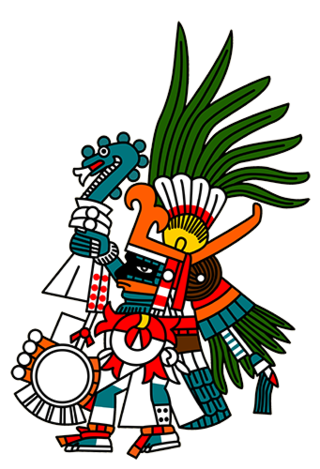
Huitzilopochtli is the solar and war deity of sacrifice in Aztec religion. He was also the patron god of the Aztecs and their capital city, Tenochtitlan. He wielded Xiuhcoatl, the fire serpent, as a weapon, thus also associating Huitzilopochtli with fire.
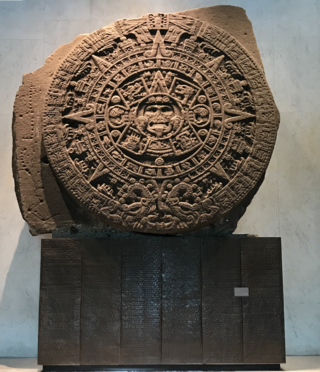
The Aztec or Mexica calendar is the calendrical system used by the Aztecs as well as other Pre-Columbian peoples of central Mexico. It is one of the Mesoamerican calendars, sharing the basic structure of calendars from throughout the region.
Tollan, Tolan, or Tolán is a name used for the capital cities of two empires of Pre-Columbian Mesoamerica; first for Teotihuacan, and later for the Toltec capital, Tula, both in Mexico. The name has also been applied to the Postclassic Mexican settlement Cholula.

The Nahuas are a Uto-Nahuan ethnicity and one of the indigenous people of Mexico, with Nahua minorities also in El Salvador, Guatemala, Honduras, Nicaragua, and Costa Rica. They comprise the largest indigenous group in Mexico, as well as the largest population out of any North American Indigenous people group who are native speakers of their respective indigenous language. Amongst the Nahua, this is Nahuatl. When ranked amongst all Indigenous languages across the Americas, Nahuas list third after speakers of Guaraní and Quechua.

Nuevo Reino de Galicia or simply Nueva Galicia, known in Nahuatl as Chimalhuacán, was an autonomous kingdom of the Viceroyalty of New Spain. It was named after Galicia in Spain. Nueva Galicia's territory consisted of the present-day Mexican states of Aguascalientes, Guanajuato, Colima, Jalisco, Nayarit and Zacatecas.

Tlacaelel I was the principal architect of the Aztec Triple Alliance and hence the Mexica (Aztec) empire. He was the son of Emperor Huitzilihuitl and Queen Cacamacihuatl, nephew of Emperor Itzcoatl, father of poet Macuilxochitzin, and brother of Emperors Chimalpopoca and Moctezuma I.

Chichimeca is the name that the Nahua peoples of Mexico generically applied to nomadic and semi-nomadic peoples who were established in present-day Bajío region of Mexico. Chichimeca carried the same meaning as the Roman term "barbarian" that described Germanic tribes. The name, with its pejorative sense, was adopted by the Spanish Empire. In the words of scholar Charlotte M. Gradie, "for the Spanish, the Chichimecas were a wild, nomadic people who lived north of the Valley of Mexico. They had no fixed dwelling places, lived by hunting, wore little clothes and fiercely resisted foreign intrusion into their territory, which happened to contain silver mines the Spanish wished to exploit." Gradie noted that Chichimeca was used as a broad and generalizing term by outsiders, writing, "[it] was used by both Spanish and Nahuatl speakers to refer collectively to many different people who exhibited a wide range of cultural development from hunter-gatherers to sedentary agriculturalists with sophisticated political organizations." They practiced animal sacrifice, and they were feared for their expertise and brutality in war.
Classical Nahuatl, also known simply as Aztec or Codical Nahuatl and Colonial Nahuatl, is a set of variants of Nahuatl spoken in the Valley of Mexico and central Mexico as a lingua franca at the time of the 16th-century Spanish conquest of the Aztec Empire. During the subsequent centuries, it was largely displaced by Spanish and evolved into some of the modern Nahuan languages in use. Although classified as an extinct language, Classical Nahuatl has survived through a multitude of written sources transcribed by Nahua peoples and Spaniards in the Latin script.

Casas Grandes is a prehistoric archaeological site in the northern Mexican state of Chihuahua. Construction of the site is attributed to the Mogollon culture. Casas Grandes has been designated a UNESCO World Heritage Site under the purview of INAH and a "Pueblo Mágico" since 2015.
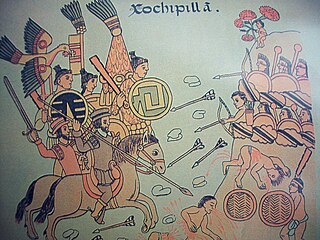
The Mixtón War (1540–1542) was a rebellion by the Caxcan people of northwestern Mexico against the Spanish conquistadors. The war was named after Mixtón, a hill in Zacatecas which served as an Indigenous stronghold.
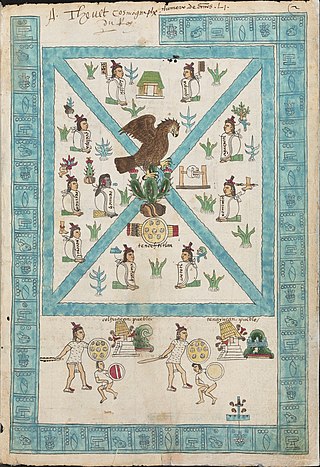
Aztec codices are Mesoamerican manuscripts made by the pre-Columbian Aztec, and their Nahuatl-speaking descendants during the colonial period in Mexico.

The traditions of indigenous Mesoamerican literature extend back to the oldest-attested forms of early writing in the Mesoamerican region, which date from around the mid-1st millennium BCE. Many of the pre-Columbian cultures of Mesoamerica are known to have been literate societies, who produced a number of Mesoamerican writing systems of varying degrees of complexity and completeness. Mesoamerican writing systems arose independently from other writing systems in the world, and their development represents one of the very few such origins in the history of writing.
Charles Corradino Di Peso was an American archaeologist. He is known for his research in Northern Mexico and the American Southwest.

Peralta is a prehispanic mesoamerican archaeological site located in Abasolo Municipality, Guanajuato, just outside the village of San Jose de Peralta in the Mexican state of Guanajuato. The site is reached via Fed 90 from Irapuato. Approximately 15.5 km south of the intersection with Fed 45, take the Irapuato-Huanimaro route southeast (left). Follow the route for about 12.5 km, then turnoff southwest (right) to San Jose de Peralta. Cross the bridge and turn right, and then follow the road out of the village northwest about 1 km. The site is on the left.

Tenayuca is a pre-Columbian Mesoamerican archaeological site in the Valley of Mexico. In the Postclassic period of Mesoamerican chronology, Tenayuca was a settlement on the former shoreline of the western arm of Lake Texcoco. It was located approximately 10 kilometres (6.2 mi) to the northwest of Tenochtitlan.
Frances Esther Karttunen, also known as Frances Ruley Karttunen, is an American academic linguist, historian and author.
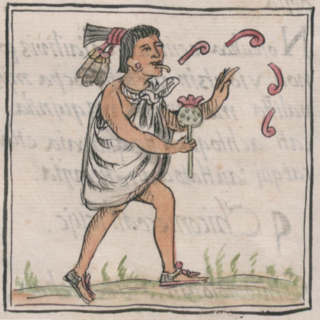
Nahuatl, Aztec, or Mexicano is a language or, by some definitions, a group of languages of the Uto-Aztecan language family. Varieties of Nahuatl are spoken by about 1.7 million Nahuas, most of whom live mainly in Central Mexico and have smaller populations in the United States.

Chichimecacihuatzin II was an Aztec princess of Tenochtitlan in Mexico.















